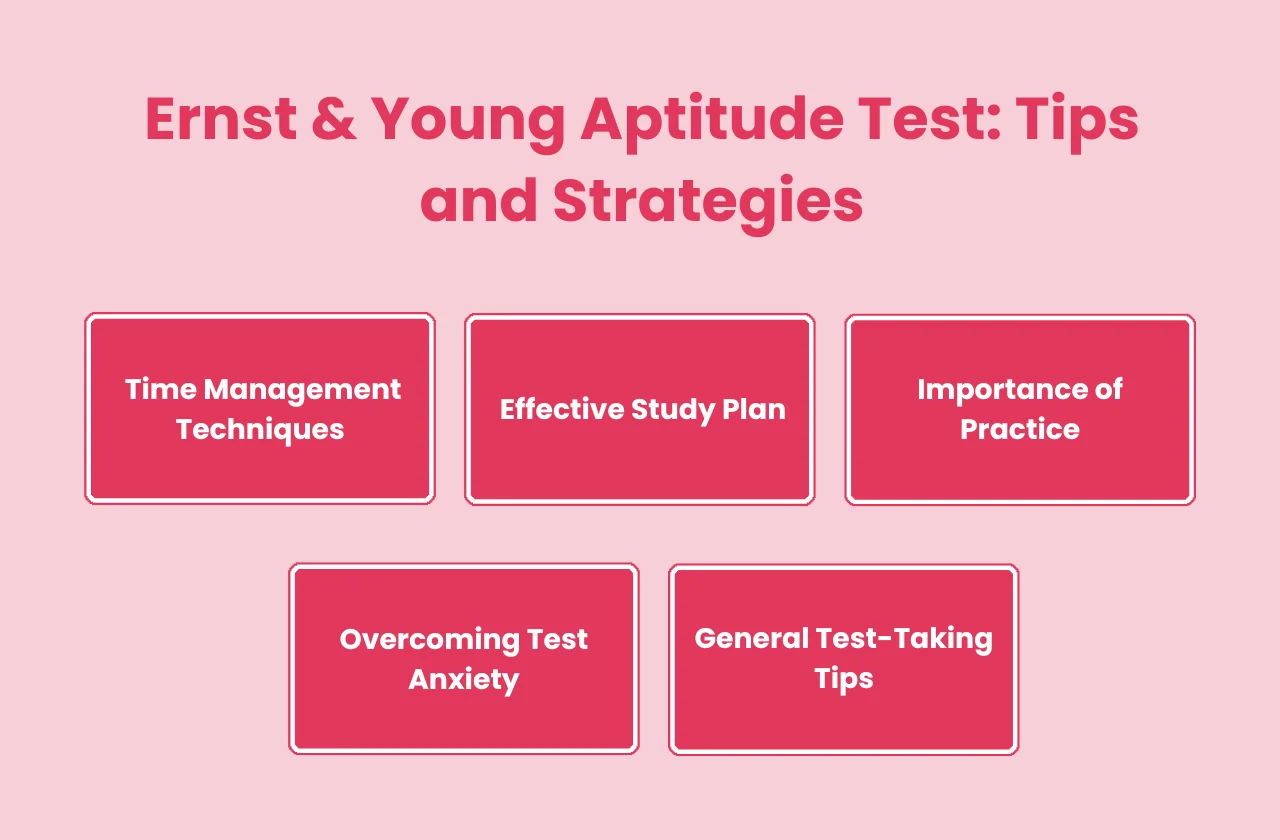Ernst & Young (EY) is one of the largest professional services firms in the world. It offers a range of services, including audit, advisory, tax, and transaction advisory services. EY operates globally, serving clients across various industries. The firm is known for its commitment to quality and integrity, providing solutions that help clients navigate complex business challenges. EY also places a strong emphasis on attracting top talent and investing in the development of its people.
Aptitude tests are a crucial part of the recruitment process at EY. These tests help the company assess a candidate’s abilities in areas such as quantitative reasoning, logical thinking, and verbal communication. Aptitude tests provide an objective way to measure skills that are essential for success in the roles EY offers. By evaluating candidates through these tests, EY ensures that they select individuals who have the potential to excel in their roles and contribute positively to the firm’s goals.
This article provides a comprehensive guide to the Ernst & Young Aptitude Test. It covers the format and structure of the test, the types of questions you can expect, and the level of difficulty. Additionally, the article includes sample questions with answers for various sections, including quantitative aptitude, logical reasoning, and verbal ability. You will also find tips and strategies to help you prepare effectively for the test. By the end of this article, you should have a clear understanding of what to expect and how to approach the EY Aptitude Test.
Understanding the Ernst & Young Aptitude Test
Here, you will learn about the structure of the EY Aptitude Test. We will cover the test format, the types of questions you can expect, and the difficulty level, giving you a clear picture of what to anticipate.
Test Format (Online/Offline, Sections, Duration)
The Ernst & Young Aptitude Test can be administered either online or offline, depending on the recruitment process. Typically, the test is divided into several sections, each focusing on different skill sets. The main sections include quantitative aptitude, logical reasoning, and verbal ability. The duration of the test may vary, but candidates usually have between 60 to 90 minutes to complete it. Each section is timed separately, so effective time management is crucial.
Types of Questions
The EY Aptitude Test includes a variety of question types. In the quantitative aptitude section, you will encounter questions related to number systems, percentages, profit and loss, simple and compound interest, ratio and proportion, time and work, time and distance, averages, and data interpretation. The logical reasoning section features verbal and non-verbal reasoning questions, including syllogisms, analogies, series completion, patterns, puzzles, spatial reasoning, data sufficiency, and critical thinking. The verbal ability section tests your reading comprehension, grammar, vocabulary, sentence correction, and para jumbles skills.
Weightage of Different Sections
Each section of the EY Aptitude Test carries different weightage, which reflects the importance of the skills being tested. Quantitative aptitude and logical reasoning typically have more weightage than verbal ability, though this can vary depending on the role you are applying for. It is essential to perform well in all sections, as a strong overall score increases your chances of progressing to the next stage of the recruitment process.
Difficulty Level of the Test
The EY Aptitude Test is considered to be of moderate to high difficulty. The quantitative aptitude and logical reasoning sections are particularly challenging, requiring a solid understanding of mathematical concepts and logical principles. The verbal ability section may be easier for those with a strong command of English, but it still requires careful reading and comprehension. Proper preparation and practice are key to successfully navigating the difficulty level of the test.
With a solid grasp of the EY Aptitude Test format and question types, you’re ready to tackle the specifics of the test sections. Let’s move on to the Quantitative Aptitude section, where we will discuss sample questions and answers.
Ernst & Young Aptitude Test Questions and Answers
In this part, we will walk you through some common E&Y aptitude questions that you might encounter in the test. Each question will be followed by a detailed solution to help you understand the approach.
1) Numerical Reasoning: Percentage Calculation
Question: If a product costs $200 and is sold at a 15% discount, what is the selling price?
Solution:
- Calculate the discount:
- 200×0.15=30
- Subtract the discount from the original price:
- 200−30=170
Answer: $170
2) Verbal Reasoning: Reading Comprehension
Question: Based on the passage, which statement is true? “The trend of eating on-the-go is increasing.”
Options:
- A) Most people eat three meals a day.
- B) Eating habits are becoming more traditional.
- C) Consumers are demanding healthier options.
- D) Breakfast is always eaten at home.
Solution: The passage indicates that traditional eating habits are declining and that consumers are looking for convenience and healthier options.
Answer: C) Consumers are demanding healthier options.
3) Logical Reasoning: Number Sequence
Question: What is the next number in the sequence: 2, 4, 8, 16, …?
Solution: Each number is multiplied by 2.
- Next number: 16×2=32
Answer: 32
4) Situational Judgement: Workplace Scenario
Question: You notice a colleague is struggling with their workload. What do you do?
Options:
- A) Ignore it; it’s not your problem.
- B) Offer to help them with their tasks.
- C) Report them to your manager.
- D) Complain about them to others.
Solution: Offering help demonstrates teamwork and support.
Answer: B) Offer to help them with their tasks.
5) Numerical Reasoning: Ratio Problem
Question: The ratio of apples to oranges in a basket is 3:2. If there are 30 apples, how many oranges are there?
Solution:
- Setup the ratio:
- 3/2 = 30/x
- Cross-multiply:
- 3x = 60
- Solve for x:
- x = 20
Answer: 20 oranges
6) Verbal Reasoning: True/False
Question: “All consumers prefer traditional eating habits.” True or False?
Solution: The passage states that traditional habits are declining.
Answer: False
7) Logical Reasoning: Shape Patterns
Question: Which shape completes the sequence: Circle, Triangle, Square, …?
Options:
- A) Pentagon
- B) Hexagon
- C) Circle
- D) Triangle
Solution: The pattern is increasing the number of sides by one each time.
Answer: A) Pentagon
8) Numerical Reasoning: Average Calculation
Question: What is the average of the numbers 10, 20, 30, 40, and 50?
Solution:
- Sum of numbers:
- 10+20+30+40+50=150
- Divide by the number of values:
- 150/5=30
Answer: 30
9) Situational Judgement: Conflict Resolution
Question: If a team member disagrees with your approach, how should you respond?
Options:
- A) Dismiss their opinion.
- B) Listen and consider their perspective.
- C) Argue your point more aggressively.
- D) Avoid discussing it.
Solution: Listening fosters collaboration and understanding.
Answer: B) Listen and consider their perspective.
10) Numerical Reasoning: Time Calculation
Question: If a train leaves at 3 PM and takes 2 hours and 45 minutes to reach its destination, what time does it arrive?
Solution:
- Add the travel time to the departure time:
- 3 PM + 2 hours = 5 PM
- 5 PM + 45 minutes = 5:45 PM
Answer: 5:45 PM
11) Logical Reasoning: Missing Number
Question: Find the missing number in the sequence: 5, 10, ?, 20.
Solution: The pattern is adding 5 each.
- Missing number:
- 5 + 5 = 10
- 10 + 5 = 15
- 15 + 5 = 20
Answer: 15
12) Verbal Reasoning: Inference
Question: Based on the text, what can be inferred about consumer behaviour?
Options:
- A) Consumers are becoming more health-conscious.
- B) All consumers dislike fast food.
- C) Traditional meals are preferred by everyone.
- D) Consumers do not care about convenience.
Solution: The text indicates a shift towards healthier and more convenient options.
Answer: A) Consumers are becoming more health-conscious.
13) Numerical Reasoning: Profit Calculation
Question: A store buys a shirt for $25 and sells it for $40. What is the profit?
Solution:
- Profit = Selling Price – Cost Price:
- 40−25=15
Answer: $15
14) Situational Judgement: Team Dynamics
Question: Your team is behind schedule. What is your first step?
Options:
- A) Blame team members.
- B) Assess the situation and adjust plans.
- C) Ignore the problem.
- D) Work overtime without consulting the team.
Solution: Assessing the situation allows for a collaborative approach to solving the issue.
Answer: B) Assess the situation and adjust plans.
15) Logical Reasoning: Word Problem
Question: If a car travels 60 miles in 1 hour, how far will it travel in 3 hours?
Solution:
- Distance = Speed × Time:
- 60×3=180
Answer: 180 miles
16) Numerical Reasoning: Discount Calculation
Question: A $50 item is on sale for 20% off. What is the sale price?
Solution:
- Calculate the discount:
- 50×0.20=10
- Sale price:
- 50−10=40
Answer: $40
17) Verbal Reasoning: Comprehension
Question: “The new policy has been well received.” What does this imply?
Options:
- A) The policy is unpopular.
- B) The policy is effective.
- C) The policy has many critics.
- D) The policy is accepted positively.
Solution: “Well received” indicates a positive response.
Answer: D) The policy is accepted positively.
18) Logical Reasoning: Sequence Completion
Question: Complete the sequence: A, C, E, G, …?
Solution: The pattern skips one letter each time (A, B, C, D, E, F, G).
Answer: I
19) Numerical Reasoning: Rate Calculation
Question: If a worker earns $15 per hour and works 40 hours a week, what is their weekly salary?
Solution:
- Weekly salary = Hourly rate × Hours worked:
- 15×40=600
Answer: $600
20) Situational Judgement: Ethical Dilemma
Question: You discover a colleague is taking credit for your work. What do you do?
Options:
- A) Confront them aggressively.
- B) Discuss the issue with them privately.
- C) Ignore it.
- D) Report them immediately.
Solution: A private discussion may resolve the issue amicably.
Answer: B) Discuss the issue with them privately.
Feeling confident about your skills? Let’s move on to some tips and strategies to help you maximise your performance.
Ernst & Young Aptitude Test: Tips and Strategies
In this section, we will share practical tips and strategies to help you prepare for the EY Aptitude Test. From time management to overcoming test anxiety, these insights will guide you toward a more effective study plan.

1) Time Management Techniques
Managing your time effectively during the EY Aptitude Test is crucial for success. Start by familiarising yourself with the test format and the types of questions you will encounter. During the test, allocate your time wisely across different sections, ensuring that you do not spend too much time on any single question. It is often helpful to tackle easier questions first to secure those marks, then return to more challenging ones. Using a timer during practice sessions can help you get accustomed to pacing yourself.
2) Effective Study Plan
An effective study plan is essential for preparing for the EY Aptitude Test. Begin by identifying the areas where you need the most improvement, whether it’s quantitative aptitude, logical reasoning, or verbal ability. Create a study schedule that allows you to focus on each section systematically. Include regular practice sessions using sample questions and past papers. Reviewing your answers to understand where you went wrong is just as important as practising. Gradually increase the difficulty of the questions as you progress.
3) Importance of Practice
Practice is key to mastering the Ernst & Young Aptitude Test. Regular practice helps you become familiar with the question types and improves your speed and accuracy. Utilise resources like iScalePro to access a wide range of practice questions specifically designed for the EY Aptitude Test. Consistent practice not only builds your confidence but also enables you to identify patterns in questions, making it easier to solve them during the actual test.
4) Overcoming Test Anxiety
Test anxiety is common, but it can be managed with the right techniques. Start by ensuring that you are well-prepared, as confidence in your knowledge reduces anxiety. Practice relaxation techniques such as deep breathing or meditation before the test. On the day of the test, make sure to get enough rest the night before and eat a healthy meal. During the test, if you feel anxious, take a few deep breaths to calm yourself. Remember that it’s normal to feel nervous, but staying focused will help you perform better.
5) General Test-Taking Tips
When taking the EY Aptitude Test, read each question carefully before answering. Avoid rushing, as this can lead to mistakes. If you encounter a difficult question, don’t spend too much time on it; move on and come back to it later if time permits. Make sure to eliminate obviously incorrect options in multiple-choice questions, which can increase your chances of selecting the right answer. Finally, double-check your answers if time allows, especially in sections where accuracy is critical.
Armed with these tips and strategies, you are now better equipped to approach the EY Aptitude Test with confidence. To conclude, we will wrap up the key points discussed and reinforce the importance of thorough preparation.
Conclusion
The Ernst & Young Aptitude Test is a significant part of the recruitment process, designed to evaluate the essential skills required for various roles within the firm. By understanding the test format, practising regularly, and employing effective test-taking strategies, you can enhance your chances of performing well.
Remember to manage your time effectively, focus on your weak areas, and stay calm during the test. With proper preparation, you can approach the EY Aptitude Test with confidence and improve your prospects of securing a position with one of the leading professional services firms in the industry.
By applying the knowledge and strategies from this article, you can approach the Ernst & Young Aptitude Test with confidence. Good preparation will not only help you perform well but also increase your chances of securing a position with EY.
FAQs Related to Ernst & Young Aptitude Test
1) How do I pass the EY assessment test?
To pass the EY assessment test, focus on these areas:
- Practice: Solve many practice tests similar to the real EY test.
- Time management: Practice solving questions within the given time limit.
- Accuracy: Ensure your answers are correct. Avoid careless mistakes.
- Understand concepts: Study basic math, logic, and reasoning concepts.
- Stay calm: Don’t panic during the test. Focus on one question at a time.
2) How do I prepare for the EY numerical test?
To prepare for the EY numerical test, do these things:
- Learn basic math: Review topics like fractions, decimals, percentages, ratios, and averages.
- Practice calculations: Do many calculations without a calculator.
- Understand data interpretation: Learn how to read and analyze charts, graphs, and tables.
- Solve practice problems: Find and solve practice problems similar to those in the EY test.
- Time yourself: Practice solving numerical problems within a set time limit.
3) What is the EY assessment like?
The EY assessment usually includes these types of questions:
- Numerical reasoning: Tests your ability to solve math problems quickly and accurately.
- Verbal reasoning: Assesses your ability to understand and analyze written information.
- Logical reasoning: Evaluates your ability to think logically and solve puzzles.
- Situational judgment: Measures your judgment and decision-making skills in work-related situations.
4) How long is an EY online assessment?
The length of an EY online assessment can vary, but it typically lasts around 1-2 hours. However, it’s best to check the specific details provided in your job application or invitation.





